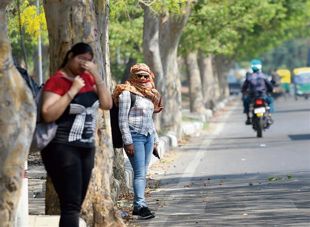
OUTREACH: US Secretary of State Antony Blinken (left) met Chinese President Xi Jinping in the Great Hall of the People in Beijing last week. Reuters
Jayadeva Ranade
President, Centre for China Analysis and Strategy
THE US Secretary of State, Antony Blinken, met Chinese President Xi Jinping, Foreign Minister Wang Yi and, quite unusually, China’s Minister of Public Security Wang Xiaohong during his three-day visit to Beijing and Shanghai from April 24 to 26. However, it was an unsuccessful attempt to arrest the slide in bilateral relations, even as he reiterated the US ‘red lines’. This was Blinken’s second trip to China in 10 months; he is the senior-most official of the Joe Biden administration to visit the country.
Not without an obvious design, Blinken’s visit took place in the backdrop of reports that Washington was identifying Chinese banks — from a list of 100 — that should be sanctioned for aiding Russia in its war with Ukraine. More disconcerting for China would be the reports that US authorities had also begun compiling lists of Chinese Communist Party cadres and their assets in the US and the West that could be covered by sanctions. The visit also coincided with the US authorising a $95-billion war aid package to Ukraine, Israel and Taiwan.
During the meetings in Beijing, China clearly conveyed that it was not prepared to yield ground and make concessions. It used the visit to set out its ‘red lines’, restate its ambitions and signal that it had serious reservations about the US claims that it wants to stabilise relations and doesn’t want to challenge China’s core interests or prevent its growth. The Dragon has been particularly apprehensive of America’s efforts to ‘friendshore’ manufacturing to ‘trusted’ partners.
Blinken’s visit came amid repeated attempts by US President Biden to reduce tensions. Chinese and US military and diplomatic officials have held numerous meetings in addition to at least 20 ongoing talks between the two countries. At the senior level, US Treasury Secretary Janet Yellen visited (April 4-9) Guangzhou and Beijing for talks with China’s senior-most finance officials to address concerns that Washington was trying to prevent Beijing’s growth. US Defence Secretary Lloyd Austin and China’s new Defence Minister, Dong Jun, had their first video talks last month, in which the latter “underscored that the Taiwan question is at the core of China’s core interests, which brook no compromise”. Early last month, Chinese Vice-Minister of Commerce Wang Shouwen travelled to Washington for the first meeting of a working group on bilateral trade, where he highlighted China’s concerns over the imposition of Section 301 tariffs by the US and associated inquiries against Beijing and demanded that both must manage their disputes and increase collaboration.
On the day prior to Blinken’s arrival in Shanghai, Yang Tao, the head of China’s department for US and Oceania, appeared to set the stage in a lengthy, strongly worded briefing to journalists. He appeared to focus on negative factors in Sino-US relations and accused America of continuing to ‘contain China’, interfering in its internal affairs and harming its interests. There was particular focus on Taiwan, which he described as “the first insurmountable red line in Sino-US relations” and “the biggest threat to peace and stability across the Taiwan Strait”. He also warned that “the Asia-Pacific region is not anyone’s back garden and should not become a battleground for major powers”. His briefing provoked questions in the US about the need for Blinken to visit Beijing.
Blinken and Chinese Foreign Minister Wang Yi had nearly five-and-a-half hours of talks, during which the latter spoke entirely from a prepared text. His remarks largely echoed Yang Tao’s comments. Wang Yi also said that “negative factors in Sino-US relations are still rising and accumulating”. He said that “China’s legitimate right to development is being unreasonably suppressed” and its core interests are being challenged. He further emphasised that the US should not interfere in China’s internal affairs, suppress its development or step on its ‘red lines’ regarding its sovereignty, security and development interests.
In his remarks to journalists, Blinken noted that the first US-China talks on artificial intelligence would be held within weeks. He also observed that since there are fewer than 900 Americans studying in China compared to more than 2,90,000 Chinese students in the US, their number should be increased.
He stressed that the US was “very clear-eyed about the challenges posed by the PRC (People’s Republic of China) and about their competing visions for the future” and asserted that America “will always defend our core interests and values”. He said he had conveyed serious concerns about China providing components that are “powering Russia’s brutal war of aggression against Ukraine”. He told Beijing that it cannot achieve better relations with Europe while supporting the greatest threat to European security since the end of the Cold War and “made clear that if China does not address this problem, we will”. He also expressed concern about Beijing’s unfair trade practices and the potential consequences of industrial overcapacity. Blinken discussed China’s ‘dangerous actions’ in the South China Sea and reaffirmed that US “defence commitments to the Philippines remain ironclad”. He emphasised the maintenance of peace and stability across the Taiwan Strait and raised the issues of Hong Kong, Xinjiang, Tibet and the wrongful detention of American citizens.
Both sides used Blinken’s visit to bluntly spell out their respective concerns. Taiwan figured extensively in the talks, with the Chinese robustly declaring it their inviolable ‘red line’. Notably, 22 Chinese fighter aircraft flew over the Taiwan Strait soon after Blinken’s departure. There was little evidence of Beijing trying to create a favourable atmosphere for the talks, despite senior Chinese officials calling for constructive China-US relations and the two countries avoiding action that could damage the relationship.
Join Whatsapp Channel of The Tribune for latest updates.




























